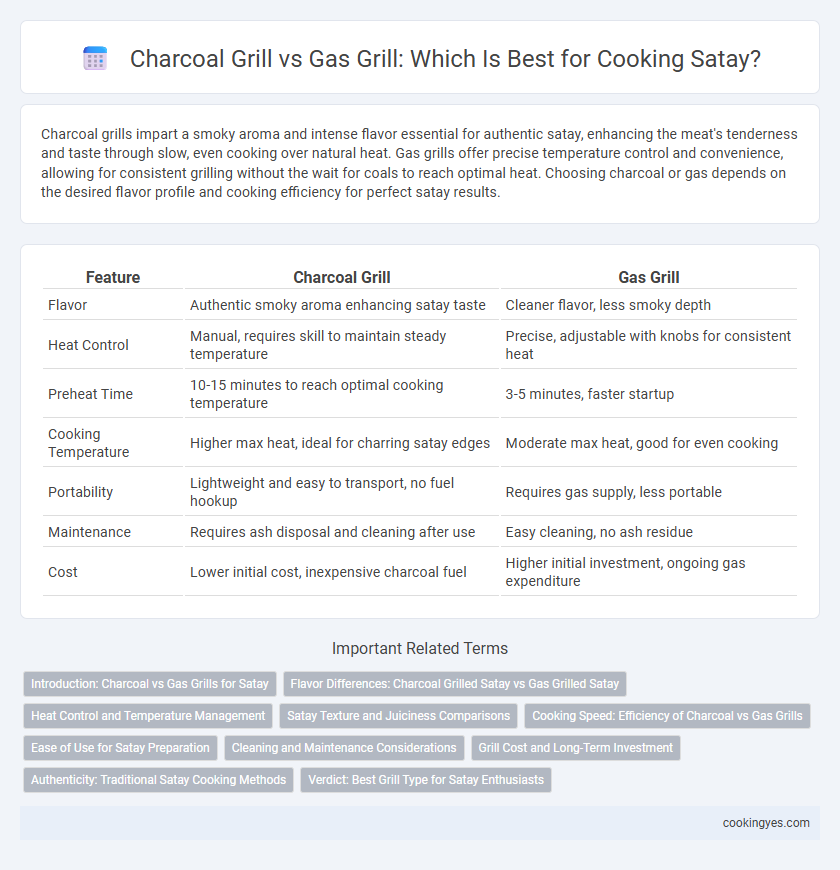Charcoal grills impart a smoky aroma and intense flavor essential for authentic satay, enhancing the meat's tenderness and taste through slow, even cooking over natural heat. Gas grills offer precise temperature control and convenience, allowing for consistent grilling without the wait for coals to reach optimal heat. Choosing charcoal or gas depends on the desired flavor profile and cooking efficiency for perfect satay results.
Table of Comparison
| Feature | Charcoal Grill | Gas Grill |
|---|---|---|
| Flavor | Authentic smoky aroma enhancing satay taste | Cleaner flavor, less smoky depth |
| Heat Control | Manual, requires skill to maintain steady temperature | Precise, adjustable with knobs for consistent heat |
| Preheat Time | 10-15 minutes to reach optimal cooking temperature | 3-5 minutes, faster startup |
| Cooking Temperature | Higher max heat, ideal for charring satay edges | Moderate max heat, good for even cooking |
| Portability | Lightweight and easy to transport, no fuel hookup | Requires gas supply, less portable |
| Maintenance | Requires ash disposal and cleaning after use | Easy cleaning, no ash residue |
| Cost | Lower initial cost, inexpensive charcoal fuel | Higher initial investment, ongoing gas expenditure |
Introduction: Charcoal vs Gas Grills for Satay
Charcoal grills impart a smoky, authentic flavor to satay that enhances its traditional taste, while gas grills offer precise temperature control for consistent cooking. The choice between charcoal and gas impacts the aroma, texture, and overall flavor profile of satay, with charcoal often preferred for its distinctive char and depth. Gas grills provide convenience and quicker heat-up times, making them suitable for frequent or large-scale satay preparation.
Flavor Differences: Charcoal Grilled Satay vs Gas Grilled Satay
Charcoal-grilled satay delivers a distinct smoky aroma and rich, deep flavor profile due to the natural combustion of wood and charcoal, which infuses the meat with subtle hints of char and earthiness. Gas grills offer more consistent heat control and convenience but tend to lack the intense smoky nuances that characterize traditional satay. The choice between charcoal and gas grilling significantly impacts the savory complexity and authenticity of the satay's flavor.
Heat Control and Temperature Management
Charcoal grills provide superior heat control and high-temperature consistency crucial for authentic satay, allowing for smoky flavors through adjustable airflow and proximity to the embers. Gas grills offer precise temperature management with quick adjustments via knobs, but lack the natural smoky aroma that enhances satay's traditional taste. Optimal satay cooking requires balancing steady heat and controlled temperature fluctuations to ensure even cooking and caramelization of the marinade.
Satay Texture and Juiciness Comparisons
Charcoal grills impart a smoky, rich flavor to satay, enhancing the texture with a slightly crisp exterior and tender, juicy interior due to slower, more even heat distribution. Gas grills offer precise temperature control, resulting in consistent cooking that maintains satay juiciness but may lack the distinctive smoky aroma and slightly charred texture associated with traditional charcoal grilling. When prioritizing satay texture and juiciness, charcoal grilling often produces a more authentic, flavorful bite, while gas grilling ensures uniform doneness with less smoky complexity.
Cooking Speed: Efficiency of Charcoal vs Gas Grills
Charcoal grills provide intense, direct heat that sears satay quickly, creating a smoky flavor and crispy exterior, but require longer preheating and inconsistent temperature control can slow cooking efficiency. Gas grills offer precise temperature control and rapid heat-up times, enabling more consistent and faster cooking of satay skewers without frequent adjustments. Comparing both, gas grills excel in cooking speed and efficiency, while charcoal grills prioritize authentic flavor at the expense of longer preparation and variable cooking times.
Ease of Use for Satay Preparation
Charcoal grills provide authentic smoky flavor essential for traditional satay but require more effort in lighting, temperature control, and cleanup compared to gas grills. Gas grills offer precise heat control and quick ignition, making satay preparation faster and more convenient, especially for beginners. The ease of use with gas grills reduces preparation time while maintaining consistent cooking conditions ideal for evenly grilled satay skewers.
Cleaning and Maintenance Considerations
Charcoal grills for satay tend to accumulate ash and residue, requiring thorough cleaning after each use to prevent buildup and maintain optimal flavor. Gas grills offer easier maintenance with removable drip trays and fewer residues, making regular cleaning quicker and less labor-intensive. Proper cleaning ensures consistent satay taste and prolongs the grill's lifespan, regardless of the type used.
Grill Cost and Long-Term Investment
Charcoal grills for satay cooking typically involve lower initial costs but require frequent purchases of charcoal, increasing long-term expenses. Gas grills demand higher upfront investment but offer greater fuel efficiency and consistent heat control, reducing overall operational costs over time. Evaluating the balance between initial grill cost and ongoing fuel expenses is crucial when choosing the optimal grilling method for satay preparation.
Authenticity: Traditional Satay Cooking Methods
Charcoal grills provide the authentic smoky flavor essential to traditional Satay, replicating the original street food experience where embers enhance the meat's aroma and tenderness. Gas grills offer convenience and temperature control but often lack the depth of flavor imparted by natural charcoal combustion. The use of charcoal preserves the cultural heritage and sensory characteristics central to genuine Satay preparation.
Verdict: Best Grill Type for Satay Enthusiasts
Charcoal grills deliver authentic smoky flavor and high heat essential for perfectly caramelized satay, enhancing the traditional taste profile. Gas grills offer convenient temperature control and faster ignition but lack the depth of flavor from wood smoke. Satay enthusiasts seeking genuine taste and texture favor charcoal grills as the superior choice for grilling satay.
Charcoal grill vs Gas grill for Satay cooking Infographic

 cookingyes.com
cookingyes.com